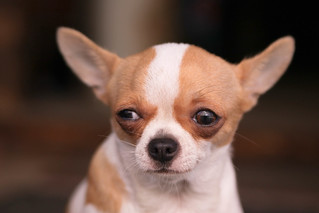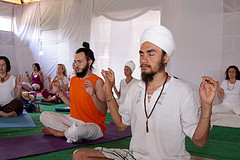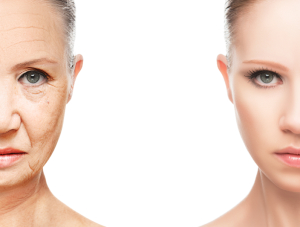GUYSIDE: Keep a weather eye out for dubious claims.

Take a hint from Pepe, and be skeptical of medical claims — the more grandiose the more skeptical!
I was watching my local newscast recently and heard about an innovative new treatment for “winter blues”, or Seasonal Affective Disorder. As someone who strongly dislikes 4 pm sunsets, I was interested enough to keep watching.
The treatment is a device called the Alpha LED Light Spa. This device, which resembles a tanning bed, offers a variety of programs that combine light, heat, and oxygen to treat a variety of symptoms. The owner of this particular device told the reporter that it was an effective treatment for more than 1000 disorders — and that REALLY got me interested. Here’s the list:
“Energizing Whole Body, Mind and Spirit, Cold/Flu, Sleep/Insomnia Improvements, Depression, Seasonal Affective Disorder, Mind Clarity, Meditation, Pain Relief, Lymphatic drainage, Wound Healing , Immune Boost, Stress Relief, Detoxification, Weight Loss, Cellulite Treatments, Skin Care – Acne Treatments, Skin Care – Anti-Aging, Addictions, Balances hormones, Migraine relief, Soothes nervous system, Lowers cholesterol, Infertility, Psoriasis, Anxiety, Inflammation, & more.”
Unfortunately, there’s no links to evidence on the site. And I haven’t been able to discover any in my time looking around. There is little doubt that SAD, disruptions in sleep due to circadian rhythms, and depression can be treated effectively by light therapy. But on the face of things, it seems unlikely that this device would be able to successfully treat more than 1000 problems.
Claims like this need to be taken skeptically, not least because at the Ottawa spa offering these treatments, it’s $75 per session.
And there’s no shortage of claims that need to be given the side-eye. Also this week, an article in the British Medical Journal looked at medical recommendations made on the Dr. Oz show and The Doctors. In the case of Dr. Oz, fewer than half of the medical recommendations provided had any sort of supporting evidence backing them up; 1 in 6 were actually contradicted by medical evidence.
It’s easy to make a medical claim, and ones that fit into what we want to hear (eat this and your belly will magically shrink!) are much more readily consumed by us humans than ones that are a little more work (eat less, move more, and stop with the Big Gulps).
You owe it to yourself to ensure the actions you take to preserve and improve your health are ones that have a basis in fact.
For those who’ve just finished celebrating Chanukah, and for those who are anticipating a visit from Santa, Merry Christmas and Happy Holidays!
(Photo is CC-licenced from Flickr user Yiie)
Read MoreGUYSIDE: salty talk about your diet
 I’ve been keeping an eye on my blood pressure these days. With a family history of hypertension, it just makes sense. And so far, my results are good. A while ago, I stopped at a local pharmacy and used their automated machine and saw a couple of readings heading into the high range. But more accurate readings have put it further down in the normal range, so that’s good.
I’ve been keeping an eye on my blood pressure these days. With a family history of hypertension, it just makes sense. And so far, my results are good. A while ago, I stopped at a local pharmacy and used their automated machine and saw a couple of readings heading into the high range. But more accurate readings have put it further down in the normal range, so that’s good.
But when I looked at my profile for hypertension risk factors, I was struck that there wasn’t a great deal I could do. The major risk factors for hypertension, according to the Mayo Clinic, are:
- Age. (Hypertension is more common in men around 45 or so, and becomes more common in women around 65)
- Race. (High blood pressure is particularly common among blacks)
- Family history.
- Being overweight or obese.
- Not being physically active.
- Using tobacco.
- Too much salt (sodium) in your diet.
- Too little potassium in your diet.
- Too little vitamin D in your diet.
- Drinking too much alcohol.
- Stress.
I do pretty well on most of these. But of the ones I can control, the one about sodium sticks out. As a man and a lover of food that I KNOW is bad for me, I know that I can be the author of my own hypertensive misfortune. Burgers, fries, onion rings, chicken wings — it would be foolish to pretend they don’t have a lot of sodium in there. But there are a ton of foods out there that you wouldn’t expect to have high sodium levels.
We often have pizzas on naan bread for a quick and easy weekday meal. On top, prosciutto, pears, brie, and basil. I knew the prosciutto would be high in sodium — after all, it’s a cured meat. But the naan bread itself has a surprising amount of sodium. Between those two ingredients, one naan pizza is likely delivering more than half my daily allowance of sodium.
Chicken breasts can be injected with brine during processing, increasing their sodium content drastically. A slice of process cheese might have 20% of your daily allowance of sodium!
If you have french fries, you expect them to be salty. But if you add a tablespoon or two of ketchup, you’re looking at 400 mg of sodium just in that!
And none of this counts restaurant or takeout food, which can be extremely high in sodium. You can see just how easy it would be to end up with more than your roughly 2,500 mg of sodium per day:
- 350 mg: a bowl of Raisin Bran.
- 870 mg: a bagel and cream cheese
- 1220 mg breakfast
- 1600 mg: 100 grams of deli ham on white bread with mustard.
- 1600 mg lunch
- 393 mg: baked chicken breast
- 418 mg: baked potato
- 460 mg: cup of canned peas
- 1271 mg supper
- 744 mg: 1/2 cup of salsa
- 420 mg: 24 tortilla chips
- 1164 mg snack
That’s a whopping 5255 mg of sodium, more than twice the recommended amount in a day, without a single shake of your salt shaker, without eating out, and with lots of things that seem healthy at first glance. (Sodium figures from the Fat Secret website)
You can’t change your age, your race, or your family history of hypertension. But if you start to track things like sodium, you do see where you can help prevent hypertension, or if you have it, improve it without resorting to drugs. And that’s a good thing.
(Pretzel photo is a CC-licenced image from Flickr user Jenn Durfey)
Read MoreGuyside: Do you have recovery time covered in your exercise?
Yoga. How hard can that be, right? Just a bunch women accessorizing and lying around on mats, right?
Uh-uh. As I type this, my large thigh muscles are complaining, and my abdominal muscles are providing harmony vocals. All this after an “ambitious” session of Kundalini yoga on Monday. As in so many instances, my pain is my fault, for two reasons:
- I have had a fairly indolent fall, with not nearly the same level of activity — yoga or otherwise — that I might expect normally.
- Being reasonably competitive and interested in seeing what others were doing in the class, I wanted to show that I wasn’t some Kundalini newbie. So I pushed myself.
And here I sit, waiting for my muscles to stop being mad at me.
Time was that such foolhardiness on my part wouldn’t have been NEARLY as big a deal. Gluttony, sudden spurts of exercise, alcoholic overindulgence, nights with very little sleep — it all was part of the game, and I (or at least I think) was able to perform quite fine under all sorts of self-imposed constraints. Now, it’s a different story. I can have late nights, but there will be a price to pay. The days of 80-chicken-wing sprees accompanied by pitchers of beer? Gone. And as my yoga experience has shown me (not for the first time), I need to gauge my level of effort when exercising and prepare for recovery time.
And it’s not just me. Science says so. An article in the Encyclopedia of Sports Medicine and Science states baldly that “The recommended dose of exercise should do no more than leave the participant pleasantly tired on the following day. Recovery processes proceed slowly, and vigorous training should thus be pursued on alternate days.” And a Harvard Men’s Health Watch article points out (too late for me this time) that it’s best to “Work yourself back into shape gradually after a layoff, particularly after illness or injury.”
This week, I brought my bike in from the garage to set it up for winter training. If I have learned one thing from Monday’s yoga class, it’s that while I can do stuff, I can do stuff better if I do it with an eye to gently bringing myself up to speed, rather than exploding out of the gate.
And the benefits of physical activity are so great and diverse that there’s no argument against moving a bit more. Now, can someone pass the Ben-Gay?
Photo: cc-licenced image from Flickr user Jamie Ramos.
Read MoreGot your skin(care) in the game of life?
Aging skin. It’s worth an occasional sigh, right? After all, at the end of the day, unless you are spending major dollars on a few nips and a few tucks and some filler and peels, well, you have to give into it.
Or do you?
The American Academy of Dermatology has issued a few wonderful tips on taking care of your skin in your 40s and 50s. I thought that I would devote today’s post to things you can do to promote good skin care:
- Protect your skin from the sun. Oh, my goodness; this should be a given at any age. With the surge in products to provide a healthy glow, there is absolutely no reason not to wear sunscreen and every reason to wear sunscreen. And as the AAD points out, protection against the sun is the formation of any skincare plan. The strategy is simple: try to avoid direct sunlight between the hours of 10 am and 2 pm, especially if your shadow looks shorter than you. Wear hats and definitely wear shades. And of course, wear a sunscreen product for the broadest protection possible. Personally, I use EltaMD UV Daily Broad Spectrum during the daytime, which my dermatologist specifically recommended for my skin type.
- Apply moisturizer daily. Oil production in the skin starts to decline around age 40 so moisturizing becomes ever more important thereafter. Many physicians say that the best time to moisturize is right after a shower or bath. Your choice of a moisturizing cream depends on your skin type, your problem areas and your individual make up. I have a mild form of rosacea and consequently, can’t use a lot of products without breaking out. Speak to a dermatologist if you have any questions about what you should use. And be mindful that your product choice may change over time.
- Wash away dirt and grime only twice a day. Did you know that your face washing habits actually affect your appearance? That’s why it’s best to wash with warm (not hot) water and use a mild cleanser in lieu of soap, which can be too harsh as skin begins to thin and lose elasticity. You should also avoid scrubbing too hard, especially if you are acne-prone. Many women experience acne during perimenopause and use and overuse of antiacne cleansers can be irritating. Rather, look for products that are non-comedogenic, nonacnegenic or oil-free.
- Stop smoking. I can’t emphasize this enough. Studies have suggested that tobacco smoke can lead to smoker’s face due to its effect on mast cells (cells that play an important role in fighting allergies and inflammation). Think of the Marlboro Man – rugged looks, i.e. dull and dry complexion, loss of skin firmness, premature lines and wrinkles may look sexy on a 30 year old but by the time you reach your 40s or 50s? Forgeddaboutit!
- Get enough sleep. Oy! This one is tough, especially during menopause. But sleep deprivation can affect the ability of the body (and the skin) to renew itself. Beauty rest? Indeed!
- Finally eat healthy foods and drink plenty of water. The AAD says that a healthy diet filled with fruits, vegs, lean proteins and healthy fats is an important key to healthy skin. And, data suggest that diet can affect multiple skin conditions other than aging, including acne, psoriasis and dermatitis.
Guyside: feeling tension over hypertension
Their Independence is My Uncertainty: Guest Post by Wendy Scherer
Every now and then a piece of writing grabs you by the heartstrings and won’t let go. This is one of those pieces of writing.
In today’s post Wendy Scherer provides an important lesson about time, filling it, desiring it and being careful what you wish for. What’s your 3.0 version???
For nearly 20 years, my most important life’s focus has been to prepare my three boys for independence. A lofty goal, I admit. There were years of carrying them around until they learned to walk and then following closely behind as they toddled and fell. There were pep talks and boo-boo kisses and Band-Aids. And there were lots of hugs and encouraging words as they started interacting with other kids. When each started preschool, I was so sad when he was gone; but the hours went quickly and each would be home soon after he left. Sure, there was crying when the carpooling started. And I cried, too, as I watched the other moms’ cars driving away. It seems that every minute of my life those days was focused on hands-on motherhood. The kids needed me (and Andrew, when he wasn’t traveling) for everything. Every. Thing.
I worked hard to give them freedom. I watched them ride their bikes until they rode out of my sight. I kissed them at the door as they left for the neighborhood tot lot. And soon, elementary school started and the days were longer. But they needed me after school. And on the weekends and evenings, they needed rides – and cheerleaders – for sports and activities.They were branching out a little. But, I had a lot of their attention, their time, and their cuddles.
When they started going to summer camp, the weeks were long without them. But they came back and I felt needed as I washed the clothes they wore doing things I only vaguely knew about and I felt joy and a mild ache as I heard tales of the new friends whose parents I didn’t know. It was starting. The independence. I wanted it for them, and yet, it terrified me. At night, I wondered and worried and hoped for the strength to know how to guide them and teach them while allowing them the space they needed to grow.
Fast forward – in a blink of an eye – more than 19 years have passed since my first son was born. He is now at college. In his second year. I’m sure he’s making good choices, but I have NO IDEA where he is most of the time. The other two boys are busy. They have active lives in BBYO. They eat dinner with us – most days – but then, they’re gone doing homework or stage crew or eco club or whatever they do. When their chores and school obligations are complete (and admittedly sometimes when they’re not), the boys are all about being social and, since our middle son has his driver’s license, they have some real freedom.
It’s not that they never need us. They do need us when they’re sick or overwhelmed or have something on their minds or when they need new clothes. Or when they’re hungry. But all this has led to a really big change for me.
I have time.
Until recently, I filled that extra time with work. I love my work and I love my clients. I can always think of new ways to do more and better for them and it could fill every waking moment. But it’s just not right. And as much as I love my clients, work is not enough. All these years, I’ve wanted more time. More time. And now, I have it. So what to do?
Swim more. I love my swim time. Golf lessons – I don’t know if it’s my thing but I know I love that I can try. Enjoy our marriage – we’ve waited for this time with baited breath and it’s great, but still a little weird and hard to find my balance. It’s a huge shift. It’s like the opposite of nesting. I’m preparing for the next stage – the stage when it’s just me and Andrew and I’m finding who I want to be; what I want to do. I always want to be a mom to by boys. It’s my heart. But I have the chance to be me again, only better and more seasoned and more free.
It’s Wendy 3.0.
It’s a little shocking, actually. It’s not as if I didn’t know they’d grow up because, of course, everyone knows that happens. But, as I’ve said for years, the days are long but the years are short and here we are… with our kids almost leading their own lives. Our evil plan of teaching them independence worked. And now, I’m paying the price and trying to figure out how to not be needed.
Stay tuned.
Read More









